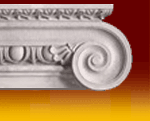The busy battle of styles of the Victorian period finally
ended in an eclectic aesthetic,
where the diverse melange of interests finally came together. With the death of Queen Victoria in 1901 after almost
64 years on the throne came a flush of new ideas, ornamentation of the Classical, and inklings of the birth of the garden
cities, suburbia, and commuter-land.
The old English classical tradition of the 18th. and 19th.centuries burst into resplendant Baroque public buildings, such as Cardiff City Hall (1897-1906) by H.V. Lanchester and Edwin Rickards. Domes were especially
popular. Notice the asymmetrically placed tower. This added a Picturesque touch to an otherwise classical design.
At the same time the Entente Cordial promoted by the francophile Edward VII encouraged a Gallic classicism, epitomised
by the Ritz Hotel in London (1903-6) designed by Charles Mewes and Arthur Davis with Parisian fašades
and Louis XVI interiors.
Another form of Edwardian classicism is sometimes known as Neo-Mannerism. Using a steel or reinforced concrete frame freed
the walls for nonstructural uses of classical forms, as in the Royal Liver Building in Liverpool
(1908-11).
19th-century experiments with reinforced concrete began to bear widespread fruit in the Edwardian era. A ferro-concrete
frame could be clad in brick or stone for prestigious buildings, or cased in concrete for more utilitarian structures. On
the right you see a clever and practical mixture. Concrete floors were left visible in bands across the brick-faced facade.
Concrete hoists are cantilevered out like oriel windows. The effect mimics Victorian stone banding and detailing on brick
buildings.
The Gothic Revival continued to dominate church architecture, though in muted form. (e.g. Liverpool
Cathedral). Mock Tudor retained its popularity for country houses, with leaded windows
and half-timbering. Traditionalist architects held sway, with Sir Edwad Lutyens (1869-1944) in
the lead. Watered-down versions of Art Nouveau, Japanese styles and
Arts and Crafts filtered down into middle-class homes.
The exteriors of the detached and semi-detached houses of this period tend to be a little simpler than those
of the Victorian period, yet with a wealth of coloured and decorative brickwork. It is also characterised by the growth
of innovative modern architectural design, mock-tudor, towers, etc.
The style is well represented in the University area of Reading (for example Elmhurst Road, Eastern Avenue,
etc . (click here for page on: Brick Ornamentation in Reading)

